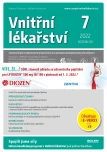Glomerulonephritides associated with infections
Authors:
Martin Havrda
Authors‘ workplace:
Interní klinika 3. lékařské fakulty UK a Fakultní nemocnice Královské Vinohrady, Praha
Published in:
Vnitř Lék 2022; 68(7): 432-437
Category:
Main Topic
doi:
https://doi.org/10.36290/vnl.2022.091
Overview
Glomerulonephritides associated with infections constitute an important group of diseases. Their occurrence is shifting from children and young people to elderly people. The rates of acute post-streptococcal glomerulonephritis, a condition with a good prognosis, are decreasing, and the rates of glomerulonephritides associated with various bacterial, viral, or parasitic infections, often with a poor prognosis, are increasing. Renal biopsy plays an important role in the diagnostic process.
Manifestations of glomerulonephritis can be the initial sign of an occult infection. When evaluating renal biopsy specimens, certain signs may suggest this option, but it cannot be relied on completely. The search for an active infection is warranted in every patient with newly diagnosed glomerulonephritis. Hepatitis B and C serology is always performed, with other investigations depending on individual risk factors, clinical manifestations, and laboratory and histological findings. Failure to follow this rule may have serious consequences, in part because immunosuppressive therapy for glomerulonephritis can worsen the underlying infection and also because the progressive nature of parainfective glomerulonephritis cannot be reversed without eliminating the causative infection. Distinguishing between parainfective and autoimmune glomerulonephritis can be difficult, as there are no major differences in clinical manifestations, laboratory, and sometimes even histological findings. In the setting of the Czech Republic, important diseases include, in particular, staphylococcus infection-associated glomerulonephritis (SAGN) and, in general, infective endocarditis-associated glomerulonephritis, shunt nephritis, and other cases associated with foreign-material infection, such as catheters or electrodes. Among viral diseases, glomerulonephritides associated with the hepatitis B virus, hepatitis C virus, and the SARS CoV-2 virus are of major significance.
The treatment of parainfectious glomerulonephritides involves elimination of the causative infection; only in rare cases, a combination of anti-infective treatment and mild immunosuppression can be indicated.
Keywords:
hepatitis – COVID-19 – glomerulonephritis – GN – infection associated – parainfectious – SAGN – postinfectious – PSGN – shunt nephritis
Sources
1. Glassock RJ, Alvarado A, Prosek J et al. Staphylococcus‑related glomerulonephritis and poststreptococcal glomerulonephritis: why defining „post“ is important in understanding and treating infection‑related glomerulonephritis. Am J Kidney, DiS. 2015 Jun;65(6):826-32.
2. Usui J, Tawara‑Iida T, Takada K et al. Temporal Changes in Post‑Infectious Glomerulonephritis in Japan (1976-2009). PLoS One. 2016 Jun 10;11(6):e0157356.
3. Floege J, Amann K. Primary glomerulonephritides. Lancet. 2016 May 14;387(10032):2036-48.
4. Jennette JC, Silva FG, Olson JL et al. Heptinstall’s Pathology of the Kidney. Wolters Kluwer, 7th Edition.
5. Turner N, Lameire N, Goldsmith DJ et al. Oxford Textbook of Clinical Nephrology. Oxford University Press 2016.
6. KDIGO 2021 Clinical Practice Guideline for the Management of Glomerular Diseases Kidney Disease: Improving Global Outcomes (KDIGO) Glomerular Diseases Work Group. Kidney International (supplement), Vol 100, Issue 4S, October 2021.
7. Bu R, Li Q, Duan ZY et al. Clinicopathologic features of IgA‑dominant infection‑associated glomerulonephritis: a pooled analysis of 78 cases. Am J Nephrol. 2015;41(2):98-106.
8. Satoskar AA, Suleiman S, Ayoub I et al. Staphylococcus Infection‑Associated GN - Spectrum of IgA Staining and Prevalence of ANCA in a Single‑Center Cohort. Clin J Am Soc Nephrol. 2017 Jan 6;12(1):39-49.
9. Sethi S, Haas M, Markowitz GS et al. Mayo Clinic/Renal Pathology Society Consensus Report on Pathologic Classification, Diagnosis, and Reporting of GN. J Am Soc Nephrol. 2016 May;27(5):1278-87.
10. Sy J, Nast CC, Pham PT et al. Membranoproliferative glomerulonephritis in patients with chronic venous catheters: a case report and literature review. Case Rep Nephrol. 2014;2014 : 159370.
11. Boils CL, Nasr SH, Walker PD et al. Update on endocarditis‑associated glomerulonephritis. Kidney Int. 2015 Jun;87(6):1241-9.
12. Kupin WL. Viral‑Associated GN: Hepatitis B and Other Viral Infections. Clin J Am Soc Nephrol. 2016 Oct 18. pii: CJN.09180816.
13. KDIGO 2018 Clinical Practice Guideline for the Prevention, Diagnosis, Evaluation, and Treatment of Hepatitis C in Chronic Kidney Disease. Kidney Disease: Improving Global Outcomes (KDIGO) Hepatitis C Work Group. Kidney International Supplements, Vol 8, Issue 3, October 2018.
14. Fervenza FC, Sethi S, Glassock RJ. Idiopathic membranoproliferative glomerulonephritis: does it exist? Nephrol Dial Transplant. 2012 Dec;27(12):4288-94.
15. Zolotov E, Sigal A, Havrda M et al. Can Renal Parameters Predict the Mortality of Hospitalized COVID-19 Patients? Kidney Blood Press Res. 2022;47(5):309-319.
16. Robbins‑Juarez SY, Qian L, King KL et al. Outcomes for Patients With COVID-19 and Acute Kidney Injury: A Systematic Review and Meta‑Analysis. Kidney Int Rep. 2020 Jun 25;5(8):1149-1160.
17. Izzedine H, Jhaveri KD. Acute kidney injury in patients with COVID-19: an update on the pathophysiology. Nephrol Dial Transplant. 2021 Jan 25;36(2):224-226.
18. Papineni P, Doherty T, Pickett T et al. Membranous glomerulonephritis secondary to Borrelia burgdorferi infection presenting as nephrotic syndrome. NDT Plus. 2010 Feb;3(1):105-6.
19. Rolla D, Conti N, Ansaldo F et al. Post‑infectious glomerulonephritis presenting as acute renal failure in a patient with Lyme disease. J Renal Inj Prev. 2013 Nov 8;3(1):17-20.
20. Schneider CA, Wiemer J, Seibt‑Meisch S et al. Borrelia and nephropathy: cryoglobulinaemic membranoproliferative glomerulonephritis responsive to doxycyclin in active Lyme disease. Clin Kidney J. 2013 Feb;6(1):77-80.
21. Kwiatkowska E, Gołembiewska E, Ciechanowski K et al. Minimal‑Change Disease Secondary to Borrelia burgdorferi Infection. Case Rep Nephrol. 2012;2012 : 294532.
22. Kirmizis D, Efstratiadis G, Economidou D et al. MPGN secondary to Lyme disease. Am J Kidney. DiS. 2004 Mar;43(3):544-51.
Labels
Diabetology Endocrinology Internal medicineArticle was published in
Internal Medicine

2022 Issue 7
Most read in this issue
- Reactive, infectious, or post‑infectious arthritis?
- Thyroid incidentalomas
- New developments in anaemia treatment – erythropoietin versus prolyl hydroxylase inhibitors?
- Current options for slowing the progression of chronic kidney disease
